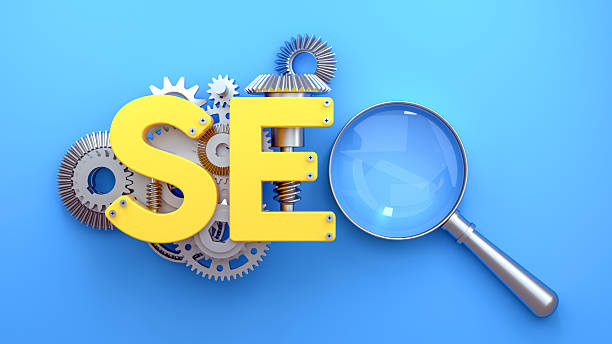Introduction to the Concept of SEO and Its Importance

In today’s world, where the internet has become an inseparable part of our lives, an online presence is vital for any business or individual.
However, merely having a website does not mean being seen.
This is where the concept of #SEO, or Search Engine Optimization, shows its importance.
#SEO is a set of techniques and strategies that help improve your website’s ranking in organic search engine results like Google.
The main goal of SEO is to increase visibility, attract quality traffic, and ultimately grow the business.
It is an educational and continuous process that requires a deep understanding of how search engines work and user behavior.
Without SEO, your website will be like a display window on a deserted street, of which few people are aware.
Therefore, investing in the knowledge and correct implementation of SEO is crucial for your online success.
In the rest of this article, we will examine various aspects of SEO and its strategies so you can guide your website to top rankings.
This #specialized knowledge is essential for every website owner, blogger, and digital marketer.
Understanding #basic_concepts and #advanced_techniques of SEO can make a big difference in the amount of #website_traffic and converting visitors into customers.
The importance of SEO goes beyond merely reaching the first page of Google; it means creating a better user experience, increasing credibility, and long-term profitability.
Therefore, understanding this field and applying it correctly is the key to success in the digital space.
Google’s SEO Starter Guide is also a valuable resource for basic learning.
Is your e-commerce site ready to attract maximum customers and increase sales? Rasaweb transforms your online business with modern and efficient e-commerce website design.
✅ Increased speed and improved SEO
✅ Excellent user experience on mobile and desktop⚡ Get a free e-commerce website design consultation from Rasaweb now!
Main Pillars of SEO and How Search Engines Work

To deeply understand SEO, we must become familiar with its main pillars and how search engines work.
Search engines like Google, using complex algorithms, index billions of web pages to provide the best and most relevant results to users.
This process has three main stages: Crawling, Indexing, and Ranking.
Crawling means discovering new and updated pages by search engine bots.
Indexing means analyzing the content of pages and storing it in the search engine’s database.
Finally, Ranking means presenting the most relevant and authoritative pages in response to user queries.
The main pillars of SEO are generally divided into three categories: Technical SEO, On-Page SEO, and Off-Page SEO.
Technical SEO includes optimizing site structure, loading speed, mobile compatibility, and sitemap.
On-Page SEO deals with optimizing content and on-page elements such as keywords, title, meta descriptions, and URL structure.
Off-Page SEO focuses on the site’s credibility and popularity outside its environment, mainly through quality link building.
Understanding these three pillars is essential for any SEO strategy.
This section provides a complete explanation of the web’s backend structure and operation.
Search engines’ ability to process and display information is the cornerstone of users’ online experience, and understanding it is an important step for any SEO professional.
How Google Search Works can also give you more information in this regard.
Keyword Research: The Pulse of Every SEO Campaign

Keyword research, as the beating heart of every SEO campaign, is the first and one of the most important steps in optimizing a website.
This process involves finding phrases and words that users type into search engines to find products, services, or information related to your business.
Choosing the right keywords not only directs relevant traffic to your website but also helps you create content tailored to user needs and intent.
Keywords can be short-tail and general, or long-tail and specific.
Long-tail keywords usually have less competition and better reflect user intent, resulting in higher conversion rates.
For keyword research, various tools such as Google Keyword Planner, Ahrefs, Semrush, and Moz Keyword Explorer can help you discover keywords, analyze search volume, competition level, and difficulty.
This specialized part of SEO requires precise analysis and understanding of audience behavior.
The goal of keyword research is not just to find high-volume keywords, but to discover words that your target audience actually uses, leading to an increase in quality traffic.
A successful keyword strategy significantly helps improve rankings in search results and increase website visibility.
This is a comprehensive guide to starting keyword research.
Types of Keywords and Their Application in SEO
| Keyword Type | Description | SEO Goal |
|---|---|---|
| Short-tail | 1-3 words, general, high search volume, high competition. Example: “coffee” |
Branding, awareness, overall traffic. |
| Long-tail | 3+ words, specific, lower search volume, clear user intent. Example: “best home espresso coffee maker” |
Attracting targeted traffic, high conversion rate, less competition. |
| Transactional | Indicates intent to buy or perform an action. Example: “buy laptop” |
Increased sales and conversions. |
| Informational | Indicates intent to gain information. Example: “how SEO works” |
Providing valuable content, increasing credibility, attracting new audience. |
Content Optimization for SEO: Attracting Audience with Powerful Keywords

After choosing suitable keywords, the next step is to optimize website content based on them.
Content SEO goes beyond merely placing keywords in the text; it is an art that requires producing valuable, engaging, and relevant content to user needs.
Quality content not only helps search engines better understand the topic of your page but also provides a better user experience, making visitors spend more time on your site.
To optimize content, factors such as Title Tag, Meta Description, proper use of headings (H1-H6), Keyword Density, text readability, and image optimization (Alt Text) should be considered.
SEO-optimized content should become thought-provoking content, meaning it should answer user questions and address their needs.
Search engines look for content that provides real value to the user, not just crammed with keywords.
Therefore, focusing on content quality and its alignment with user search intent is crucial.
Publishing fresh and updated content also sends a positive signal to search engines, indicating that your website is active and relevant.
This approach helps SEO not only improve your ranking but also build user trust and loyalty.
Content optimization is an integral part of a comprehensive SEO strategy that directly impacts attracting and retaining audiences.
Are you tired of your company’s website not being seen as it should be, losing potential customers? Solve this problem forever with professional and effective website design by Rasaweb!
✅ Increase brand credibility and build customer trust
✅ Attract targeted sales leads
⚡ Contact us now for a free consultation!
Technical SEO: The Foundation of Sustainable Ranking

Technical SEO might be less visible than content creation, but without it, your efforts in other areas of SEO might be fruitless.
This part of SEO focuses on optimizing the technical aspects of your website so that search engines can easily crawl, index, and rank it.
Important factors in technical SEO include site loading speed, mobile compatibility, optimized URL structure, the presence of an XML sitemap, robots.txt file, proper use of Canonical Tags, and Schema Markup.
Site speed is not only crucial for user experience but also an important ranking factor for Google.
Slow websites can have a higher Bounce Rate and harm your SEO credibility.
Mobile compatibility is also highly important due to the significant increase in mobile device usage for internet access, and Google gives better rankings to Mobile-Friendly websites.
Structured data helps search engines better understand your content and display it in more engaging ways (such as Rich Snippets) in search results.
This specialized area of SEO requires high technical knowledge and precision.
Without a strong technical infrastructure, even the best content might not be properly seen by search engines.
Therefore, conducting regular technical SEO audits is essential to ensure your website’s health and serves as the foundation for sustainable ranking on Google.
Link Building and Off-Page SEO: Credibility for Your Website

Link Building or Off-Page SEO refers to a set of activities performed outside your website that help improve its ranking in search engines.
The most important part of these activities is acquiring quality backlinks from authoritative and relevant websites.
Backlinks act like a vote of confidence from other websites, showing search engines that your content is valuable and trustworthy.
The more authoritative websites link to you, the more your website’s credibility and Domain Authority will increase, which helps improve your ranking in search results.
Link-building strategies include creating shareable content, publishing guest posts on relevant websites, building Internal Linking, using Social Signals, and participating in specialized forums.
The quality of links is far more important than their quantity.
Low-quality or spam links can harm your SEO and even lead to penalties from Google.
Additionally, publishing news about your website in reputable media or news articles can bring valuable backlinks for you.
Ultimately, the goal of Off-Page SEO is to increase search engine credibility and trust in your website.
This process is time-consuming but yields sustainable results and gives your website real credibility.
For a successful SEO professional, a precise understanding of this concept is vital.
Data Review and Analysis in SEO: Your Path to Progress

After implementing various SEO strategies, it’s important to regularly analyze and review your website’s performance.
Tools like Google Analytics and Google Search Console are invaluable resources for collecting and analyzing data related to website traffic, user behavior, keywords, and search performance.
Google Analytics allows you to view precise information about the number of visitors, time spent on site, popular pages, conversion rates, and user paths.
This information helps you identify your website’s strengths and weaknesses and make data-driven decisions for future optimizations.
Google Search Console also provides vital information about how your website appears in search results, including keywords users used to find your site, Click-Through Rate (CTR), and crawl or indexing issues.
By analyzing this data, you can improve your SEO strategy, refine your content, and fix technical issues.
This continuous analytical process defines your path to progress in SEO and ensures that your efforts lead to desired results.
Correct understanding and interpretation of these metrics are essential for long-term SEO success.
Key SEO Metrics and Their Meaning
| Metric | Meaning | Importance in SEO |
|---|---|---|
| Organic Traffic | Number of visitors from search engines | Directly indicates SEO success |
| Keyword Rankings | Website position for specific keywords | Indicates keyword and content strength |
| Bounce Rate | Percentage of users who leave the site without interacting with it | Indicates content quality and user experience |
| Page Speed | Website page loading speed | Important for user experience and Google ranking |
| Backlinks | Number and quality of links received from other sites | Main factor for credibility and Domain Authority |
Local SEO: How to Get Seen in Your Area

For businesses targeting local customers, Local SEO is a highly vital strategy.
Local SEO helps optimize your business’s online presence to appear in local search results; for example, when a user searches for “best restaurant in Tehran” or “mobile repair near me”.
The most important tool for local SEO is Google My Business (GMB).
By creating and optimizing your GMB profile, you can display important business information such as address, phone number, operating hours, website, and customer reviews in Google search results and Google Maps.
Other important factors in local SEO include Consistency of NAP (Name, Address, Phone Number) across all online directories, collecting positive customer reviews, and creating local content.
Local content can include blog posts about local events, attractions, or news related to your local community.
This specialized strategy helps physical businesses lead in local competition and attract potential customers.
Optimizing for local SEO not only increases physical traffic to your shop or office but also strengthens your online credibility in your specific geographic area.
This part of SEO has become increasingly vital for small and medium-sized businesses.
Are you frustrated with your online store’s low conversion rate?
Rasaweb, with its professional e-commerce website design, is your definitive solution!
✅ Increase your sales and revenue
✅ Unparalleled user experience for your customers
⚡ Get a free consultation now!
The Future of SEO and Emerging Trends in the Coming Years

The world of SEO is constantly changing and evolving, and keeping up with new trends is essential to maintain a competitive advantage.
In the coming years, several important trends will shape the future of SEO.
Voice Search will gain increasing importance due to the growing use of voice assistants like Siri, Alexa, and Google Assistant.
Optimizing for voice search requires focusing on conversational keywords and complete questions.
Artificial Intelligence (AI) and machine learning will also play a more prominent role in search engine algorithms, helping them better understand user intent and provide more accurate results.
This means content quality and relevance will become even more important.
Google’s E.E.A.T (Experience, Expertise, Authoritativeness, Trustworthiness) will also be an important criterion for evaluating content quality and website credibility.
Video optimization, given the increasing popularity of visual content, is another important trend.
Optimizing video titles, descriptions, and tags for platforms like YouTube and Google can attract significant traffic.
Even entertaining content can play an important role in attracting an audience and improving SEO.
Ultimately, User Experience (UX) will be central; websites that provide the best experience to their users will also be more successful in rankings.
By understanding these trends and adapting your SEO strategy to them, you can prepare for the future of the web and surpass competitors.
Summary and Practical Strategies for Sustainable SEO Success

In this article, we comprehensively examined various dimensions of SEO; from introductions and main pillars to keyword research, content optimization, technical SEO, link building, data analysis, local SEO, and future trends.
The main point is that SEO is not a one-time process but a continuous and dynamic effort that requires constant updates and adaptation to changes in search engine algorithms and user behavior.
To achieve sustainable success in SEO, there are a few practical and key guidelines: First, always focus on producing high-quality and valuable content that answers user questions and meets their needs.
Second, pay attention to the technical aspects of your website; speed, mobile compatibility, and a strong technical structure are the foundations of successful SEO.
Third, strive to gain quality backlinks and increase your domain authority.
Fourth, use analytical tools to monitor your performance and identify opportunities and issues.
And fifth, always stay informed about the latest trends and algorithmic updates and adjust your strategy accordingly.
By adhering to these principles, you can guide your website to the top ranks on Google and attract organic and quality traffic to your business.
Success in SEO requires patience, perseverance, and continuous learning, but its reward is being seen on the world’s largest search platform.
Frequently Asked Questions
| Question | Answer |
|---|---|
| What is SEO? | SEO, or Search Engine Optimization, is the process of increasing the quality and quantity of website traffic by improving site ranking in natural (organic) search engine results like Google. |
| What are the main types of SEO? | SEO is divided into three main categories: On-Page SEO, Off-Page SEO, and Technical SEO. |
| What does On-Page SEO include? | On-Page SEO involves optimizing elements within the website, such as keywords, Title Tags, Meta Descriptions, content, URL structure, images, and internal links. |
| What is Off-Page SEO? | Off-Page SEO refers to activities outside the website that help improve its ranking, such as Backlink Building, social media marketing, and Brand Mentions. |
| What is Technical SEO? | Technical SEO involves optimizing the technical aspects of a website to help it be better crawled and indexed by search engines. This includes site speed, mobile-friendliness, site structure, Sitemaps, and the Robots.txt file. |
| What role do Keywords play in SEO? | Keywords are phrases that users enter into search engines. Proper and targeted use of relevant keywords in content and site elements helps search engines understand your page’s topic and display it for relevant searches. |
| What is a Backlink and why is it important? | A backlink, or inbound link, is a link from one website to another. Backlinks act as a “vote of confidence” from other sites for search engines and play an important role in a site’s credibility and ranking, especially if they come from reputable sites. |
| What impact does quality content have on SEO? | High-quality, relevant, comprehensive, and unique content not only attracts and retains users but also signals to search engines that your page is valuable. This helps improve ranking, reduce Bounce Rate, and increase user time on site. |
| Why is site loading speed important for SEO? | Site loading speed is an important ranking factor for Google. Faster sites offer a better user experience, have lower bounce rates, and are preferred by search engines. |
| Is SEO a one-time process? | No, SEO is a continuous and long-term process. Search engine algorithms are constantly changing, competition is increasing, and site content needs updating. Therefore, SEO requires continuous monitoring, analysis, and optimization. |
And other services of Rasa Web advertising agency in the field of advertising
Smart Sales Automation: An effective tool for campaign management through key page optimization.
Smart Link Building: An effective tool to increase sales through key page optimization.
Smart Google Ads: Designed for businesses looking to increase click-through rates through key page optimization.
Smart Customer Journey Map: Designed for businesses looking for online growth through an SEO-driven content strategy.
Smart Brand Identity: A combination of creativity and technology to increase click-through rates by customizing user experience.
And over hundreds of other services in the field of internet advertising, advertising consultation, and organizational solutions
Internet Advertising | Advertising Strategy | Advertorial
Sources
Specialized SEO Articles
Comprehensive SEO Training
SEO Principles in Persian Web
What is SEO? A Complete Guide
? Looking to grow and gain visibility in the online world? Rasaweb Afarin Digital Marketing Agency, with expertise in custom website design, SEO, and advertising campaign management, paves the way for your business success.
📍 Tehran, Mirdamad Street, next to Bank Markazi, Kazerun Jonubi Alley, Ramin Alley, No. 6


